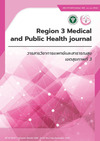Success Rate and Related Factors After the First dose of Radioiodine Therapy for Graves’ disease in Suratthani Hospital
Keywords:
Success rate, Graves’ disease, radioiodine, I-131Abstract
Background: The advantages of dose correction for thyroid gland size are simpler and more cost-effective for radioiodine (I-131) therapy in patients with Graves’ disease. The success rate and related factors after this treatment choice remain unclear.
Objective: To determine the success rate and related factors after the first dose of radioiodine therapy in Suratthani Hospital.
Material and methods: A cross-sectional analytical study was conducted on patients with Graves’ disease who received the first dose of I-131 therapy in Suratthani Hospital between August 2018 and January 2022. The dose of I-131 was categorized into 10, 15, 20, 25, and 30 mCi according to thyroid gland size of ≤ 50, 50-100, 101-150, 151-200, and >200 grams, respectively. Clinical data and related factors were analyzed by logistic regression analysis.
Results: Most patients were female (n= 257, 68.5%). The mean age was 42.0 ± 13.5 years. The success rate after the first dose of radioiodine therapy was 62.9% (n= 236). Most of them were overt hypothyroidism (n=151, 40.3%). Multivariable analysis showed a significant association between thyroid gland size 101-150 grams (adjusted OR 1.91, 95%CI 1.11-3.99, p-value=0.04) 151-200 grams (adjusted OR 6.50, 95%CI 2.19-19.33, p-value<0.001) and duration from diagnosis to I-131 therapy >18 months (adjusted OR 1.91, 95%CI 1.17-3.14, p-value=0.01) and the treatment outcome.
Conclusion: The success rate after the first dose of radioiodine therapy for Graves’ disease in Suratthani Hospital was 62.9%. Large thyroid gland size and longer duration from diagnosis to I-131 therapy were significantly associated with successful treatment.
Keywords: Success rate, Graves’ disease, radioiodine, I-131
References
Ross DS, Burch HB, Cooper DS, Greenlee MC, Laurberg P, Maia AL, et al. 2016 American Thyroid Association Guidelines for Diagnosis and Management of Hyperthyroidism and Other Causes of Thyrotoxicosis. Thyroid 2016;26:1343-421.
Kahaly GJ, Bartalena L, Hegedüs L, Leenhardt L, Poppe K, Pearce SH. 2018 European Thyroid Association Guideline for the Management of Graves’ Hyperthyroidism. Eur Thyroid J 2018;7: 167-86.
Okosieme OE, Taylor PN, Evans C, Thayer D, Chai A, Khan I, et al. Primary therapy of Graves’ disease and cardiovascular morbidity and mortality: a linked-record cohort study. Lancet Diabetes Endocrinol 2019;7:278-87.
Subekti I, Pramono LA. Current Diagnosis and Management of Graves’ Disease. Acta med Indones 2018;50(2):177-82.
Silberstein EB, Alavi A, Balon HR, Clarke SE, Divgi C, Gelfand MJ, et al. The SNMMI practice guideline for therapy of thyroid disease with 131I 3.0. J Nucl Med 2012;53:1633-51.
Canto AU, Dominguez PN, Jimeno CA, Obaldo JM, Ogbac RV. Comparison of Fixed versus Calculated Activity of Radioiodine for the Treatment of Graves Disease in Adults. Endocrinol Metab (Seoul, Korea) 2016;31:168-73.
Kalinyak JE, McDougall IR. How should the dose of iodine-131 be determined in the treatment of Graves’
hyperthyroidism? J Clin Endocrinol Metab 2003;88:975-7.
Park H, Kim HI, Park J, Park SY, Kim TH, Chung JH, et al. The success rate of radioactive iodine therapy for Graves’ disease in iodine-replete area and affecting factors: a single-center study. Nucl Med Commun 2020;41:212-8.
Wong KK, Shulkin BL, Gross MD, Avram AM. Efficacy of radioactive iodine treatment of graves’ hyperthyroidism using a single calculated (131)I dose. Clin Diabetes Endocrinol 2018;4:20.
Sztal-Mazer S, Nakatani VY, Bortolini LG, Boguszewski CL, Graf H, de Carvalho GA. Evidence for higher success rates and successful treatment earlier in Graves’ disease with higher radioactive iodine doses. Thyroid 2012;22:991-5.
Shalaby M, Hadedeya D, Toraih EA, Razavi MA, Lee GS, Hussein MH, et al. Predictive factors of radioiodine therapy failure in Graves’ Disease : A meta-analysis. Am J Surg 2022;223:287-96.
Kuanrakcharoen P. Success Rates and their Related Factors in Patients Receiving Radioiodine (I-131) Treatment for Hyperthyroidism. J Med Assoc Thai 2017;100 Suppl 1:S183-91.
Vija Racaru L, Fontan C, Bauriaud-Mallet M, Brillouet S, Caselles O, Zerdoud S, et al. Clinical outcomes 1 year after empiric 131I therapy for hyperthyroid disorders: real life experience and predictive factors of functional response. Nucl Med Commun 2017;38:756-63.
Walter MA, Briel M, Christ-Crain M, Bonnema SJ, Connell J, Cooper DS, et al. Effects of antithyroid drugs on radioiodine treatment : systematic review and meta-analysis of randomised controlled trials. BMJ 2007;334:514.
Bonnema SJ, Bennedbaek FN, Veje A, Marving J, Hegedüs L. Propylthiouracil before 131I therapy of hyperthyroid diseases : effect on cure rate evaluated by a randomized clinical trial. J Clin Endocrinol Metab 2004;89:4439-44.
Pirnat E, Zaletel K, Gaberšček S, Hojker S. The outcome of 131I treatment in Graves’ patients pretreated or not with methimazole. Hell J Nucl Med 2011;14:25-9.
Bonnema SJ, Hegedüs L. Radioiodine therapy in benign thyroid diseases: effects, side effects, and factors affecting therapeutic outcome. Endocr Rev 2012;33:920-80.
Kobe C, Weber I, Eschner W, Sudbrock F, Schmidt M, Dietlein M, et al. Graves’ disease and radioiodine therapy. Is success of ablation dependent on the choice of thyreostatic medication? Nuklearmedizin Nuclear medicine. 2008;47(4):153-6.
Downloads
Published
How to Cite
Issue
Section
License
Copyright (c) 2023 Region 3 Medical and Public Health Journal - วารสารวิชาการแพทย์และสาธารณสุข เขตสุขภาพที่ 3

This work is licensed under a Creative Commons Attribution-NonCommercial-NoDerivatives 4.0 International License.



